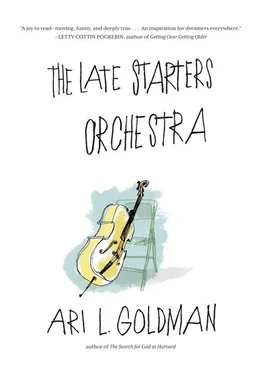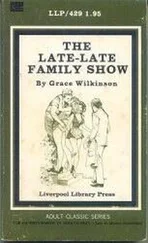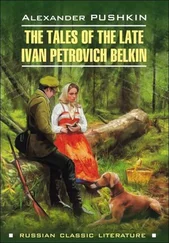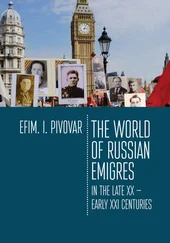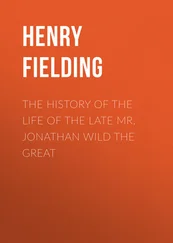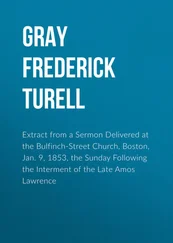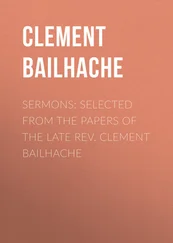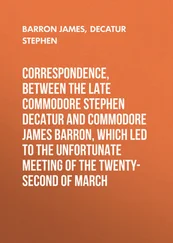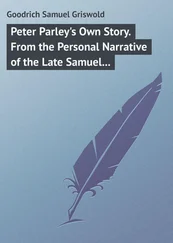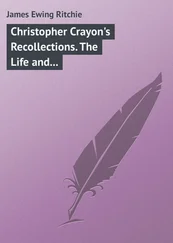When I returned I positioned the chair between myself and the bed frame. The woman took her seat, nodded her thanks, and then whispered, “Hi. I’m Eve. Now if they only got rid of the fucking bed, we’d have room to play.”
Profanity was the last thing I expected to hear in this classical music environment. But that was before I met Eve and some of her brash and racy friends in their seventies. Although Eve looked like my grandmother, she didn’t sound like her. But I was happy to have Eve next to me. She was a more experienced player and helped me find my way when I got lost in the score. My chief weakness as a player is rhythm, the vital necessity to keep a steady beat. But Eve was a metronome. Some musicians keep the beat in their heads; Eve was of the foot-tapping variety. With her next to me, I just followed her tapping foot. And, once again, she turned back into this maternal figure, keeping a steady pace. I was reminded of listening to my mother’s heartbeat when I put my head on her breast as a young child. And it reminded me of another one of Mr. J’s teachings: Rhythm emerges from your body.
Rhythm is the organizing principal of the natural world — and of our lives, too. Listen to your heartbeat. Listen to your breathing. Be aware of your footsteps. The beat is not something you have to learn. It is something you have to let come forth from your very being.
Including Eve and myself, there were eight cellists in our group that day as well as an equal complement of violinists plus two violists and one double bassist. To a classical music outsider, we were all playing the same string instrument made of wood, just ones in different sizes. In size, the violin is the smallest (at twenty-three inches, just slightly longer than the average newborn) and then up the scale to the viola (twenty-seven inches, a baby at nine months) to the cello (forty-eight inches, a preteen) to the double bass (sixty to seventy inches, a full-size adult). We were a family, unified by a similar look, but each with distinct hues and voices. At later rehearsals, we would be joined by additional string players, but we rarely numbered more than thirty instruments. Sometimes an amateur clarinetist or a flutist would wander into our rehearsal. We’d immediately spot them by the small instrument case they carried and we’d brace ourselves for the awkward conversation that would be sure to follow. “Sorry, but we’re a string orchestra. Strings only.” We’d direct them to other amateur ensembles that were full orchestras, such as the Downtown Symphony.
There’s a lot you can do with a string orchestra. We played Dvořák, Offenbach, Vivaldi, and Mozart that first day alone. The music was challenging but possible. I avoided any major embarrassments.
As I settled in, I realized that Eve was among the most experienced players in the group, which was founded in 2007, two years before my first rehearsal with them. While I was looking to her for guidance, I saw others looking to me! Yes, I sometimes got lost on the page of music, but a woman named Margaret, even older than Eve, was having trouble finding the right page. I was to learn that Margaret was actually a competent musician who took the orchestra very seriously. Her main problem was that she was somewhat deaf and did not hear when the conductor announced what piece of music we were playing. She looked about anxiously to see what page we were on, but once the music started, she joined in. It seemed that her deafness was limited to speech; she could hear music quite well. This is something that many older players experience, perhaps because playing an instrument is not simply an aural sensation but a physical one as well. The musical vibrations can help you find your way. The music comes from you and goes right back into you, Mr. J said.
There are telltale signs of a cello beginner — colored tape on the neck of the cello (to indicate where to put the fingers of your left hand to get the right sound) and a red dot smack in the middle of the bow (to help you gage the distance you have left when playing a full bow). A middle-aged cellist named Mark had both. He called them his “crutches” and said that they got him through the session without making too many mistakes. He spent much of the first session playing what might be called “air cello,” moving one’s bow right over the string so that it looks like you are playing but not risking making a sound. “My ultimate crutch,” he told me with a smile.
Clearly some of us did not know what we were doing, but that didn’t stop us. Built into the system was the reality that the more accomplished players (like Eve, and some even better) would carry the less adept, like Mark, and that, eventually, with repetition and hard work and support, everyone would be brought up to a higher musical level. Meeting Mark and others also helped me realize that my fears were unfounded. In this group of amateurs, I was more at the middle of the pack than at the bottom. I could play. I could contribute something to this orchestra.
Playing cello with this group made me part of something larger than myself. Although there was hardly any conversation between the players, a true sense of camaraderie developed. Without even talking, I could feel it in the air. As members of the New York Late-Starters String Orchestra, we were making music.
The founders of the orchestra insisted on using our full acronym — NYLSO — but I was tickled to use the shorter version, LSO. For classical music lovers, LSO means only one thing: the London Symphony Orchestra, one of the great music ensembles of the world. The idea that I had something in common with the LSO, if only three letters, was too delicious for me to pass up. I signed up as a cellist with NYLSO, but among my friends and family I spoke of LSO.
When that first rehearsal was over, it was like waking from a dream. I had pulled something off that I couldn’t have done by myself. We’d made music together, rather sophisticated classical music, even if it didn’t always sound so sophisticated. Magda, our conductor, left immediately after the two-hour rehearsal, but many of us spoke excitedly as we packed up our instruments. Eve introduced me to a cellist named Mary and they both urged me to also check out another adult orchestra, the Downtown Symphony, which met at the Borough of Manhattan Community College near Ground Zero. I was interested until Mary told me that I would have to audition to get in. My musical insecurities immediately resurfaced.
Audition is a scary word; it reminds me of a test. Tests freak me out. They make me feel like I will be exposed, uncovered as a fraud. I suppose that is the one A I don’t relate to; the A on a test. I wasn’t sure I could ace an audition.
The beauty of the Late Starters Orchestra, you see, is that there is no audition. If you think you can play with the Late Starters, you can play. You’re in. The official LSO guidelines are that newcomers should have been playing their instrument “for one year.” But no one checks, no one asks. And, even if they did, playing for a year can mean a lot of different things: Once a day? Once a week? Once a month? Once, period? No one asks because LSO was founded on the premise that serious music isn’t only for the accomplished musician. Playing music should be accessible to all, not just the elite, not just the talented, not even just the good, but everyone. And that is what LSO practices, even if that music doesn’t go much beyond the glorious A played while tuning up.
“I’m not sure I’m good enough for the Downtown Symphony,” I told Eve and Mary.
“You come,” Mary said, pointing her finger at me. “You may not live long enough to be ‘good enough.’ ” Here was another twist on the late-starter philosophy emerging. At this age — and Mary had a good ten to fifteen years on me — don’t put off things for tomorrow. Play now!
Читать дальше
